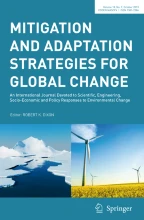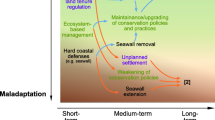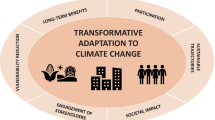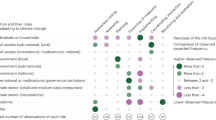
Developing generalized theories about adaptation to climate change requires common concepts to map different adaptation situations. The paper aims to contribute to this endeavor by presenting a novel framework that conceptualizes adaptations to climate change as actions. The framework is intended to systematically analyze the actor relations involved in adaptations and the barriers to their implementation. By combining established scientific action theories with terminology from the Intergovernmental Panel on Climate Change (IPCC) in an innovative way, it can be used to clarify the notion of adaptation used in adaptation assessments. The framework’s potential is illustrated by a case study on cooling water management in the river Rhine catchment and by the elucidation of some prominent concepts in adaptation research. We show that by framing adaptations as actions, the purpose of adaptations and how they tend to connect up in means-ends-chains becomes crucial. Actors can take different functional roles as exposure unit, operator and receptor of adaptation. A mismatch of these roles can lead to barriers to adaptation, of which we deduce four types: complex actor relations, missing operators, missing means and unemployed means. The case study yields a complex bundle of adaptations, and shows that the potential barriers involved are quite diverse. There is thus no blueprint solution. Although we identify entry points for adaptation, the analysis leads to a skeptical conclusion for adapting cooling water management in the whole Rhine catchment.
This is a preview of subscription content, log in via an institution to check access.
Subscribe and save
Springer+ Basic
€32.70 /Month
- Get 10 units per month
- Download Article/Chapter or eBook
- 1 Unit = 1 Article or 1 Chapter
- Cancel anytime
Buy Now
Price includes VAT (France)
Instant access to the full article PDF.
Rent this article via DeepDyve
Similar content being viewed by others

Frontiers in Climate Change Adaptation Science: Advancing Guidelines to Design Adaptation Pathways
Article 20 November 2020

Transformative adaptation as a sustainable response to climate change: insights from large-scale case studies
Article 12 February 2022

Article Open access 12 October 2023
References
- Adger WN, Barnett J (2009) Four reasons for concern about adaptation to climate change. Env Plan A 41:2800–2805 ArticleGoogle Scholar
- Adger WN, Arnell NW, Tompkins EL (2005) Successful adaptation to climate change across scales. Global Environ Change 15:77–86 ArticleGoogle Scholar
- Adger WN, Dessai S, Goulden M, Hulme M, Lorenzoni I, Nelson DR, Naess LO, Wolf J, Wreford A (2009) Are there social limits to adaptation to climate change? Clim Chang 93:335–354 ArticleGoogle Scholar
- Arnell NW (2010) Adapting to climate change: an evolving research programme. Clim Chang 100:107–111 ArticleGoogle Scholar
- Arnell NW, Delaney EK (2006) Adapting to Climate Change: Public Water Supply in England and Wales. Clim Chang 78:227–255 ArticleGoogle Scholar
- Bohle HG (2001) Vulnerability and criticality: perspectives from social geography. IHDP Update 2(01):3–5 Google Scholar
- Brooks N (2003) Vulnerability, risk and adaptation: a conceptual framework. Working Paper 38. Tyndall Centre for Climate Change Research
- BUND (2009) Wärmelast Rhein, Study of the Bund für Umwelt und Naturschutz Deutschland (BUND). BUND Rheinland-Pfalz, Mainz, Germany Google Scholar
- Carter TR, Parry ML, Harasawa H, Nishioka S (1994) Technical Guidelines for Assessing Climate Change Impacts and Adaptations. Department of Geography. University College London, London Google Scholar
- Eisenack K, Stecker R, Reckien D, Hoffmann E (2011) Adaptation to climate change in the transport sector: a review. PIK Report 122. Potsdam Institute for Climate Impact Research
- Engle NL (2011) Adaptive capacity and its assessment. Global Environ Change 21:647–656 ArticleGoogle Scholar
- Förster H, Lilliestam J (2010) Modeling thermoelectric power generation in view of climate change. Reg Environ Change 10(4):327–338 ArticleGoogle Scholar
- Frijters I, Leentvaar J (2003) Rhine Case Study. UNESCO-IHP, Technical Documents in Hydrology, 17 Google Scholar
- Füssel HM (2007a) Adaptation planning for climate change: concepts, assessment approaches, and key lessons. Sustain Sci 2:265–275 ArticleGoogle Scholar
- Füssel HM (2007b) Vulnerability: a generally applicable conceptual framework for climate change research. Global Environ Change 17:155–167 ArticleGoogle Scholar
- Gallopín G (2006) Linkages between vulnerability, resilience and adaptive capacity. Global Environ Change 16(3):293–303 ArticleGoogle Scholar
- Greis S, Stauch U, Rothstein B (2011) Untersuchungen zur Gewässertemperaturentwicklung ausgewählter Flüsse mit thermischen Kraftwerksstandorten in Deutschland. Korrespondenz Wasserwirtschaft 2011(1):37–42 Google Scholar
- Hinkel J (2007) Adaptation problem types. In: Proceedings of the Amsterdam Conference on the Human Dimensions of Global Environmental Change 2007, Amsterdam
- IKSR (2009) Analyse des Kenntnisstands zu den bisherigen Veränderungen des Klimas und zu den Auswirkungen der Klimaänderung auf den Wasserhaushalt im Rhein-Einzugsgebiet: Literaturauswertung, International Commission for the Protection of the Rhine (IKSR). Koblenz, Germany Google Scholar
- IPCC (2001) Climate Change 2001: Impacts, Adaptation and Vulnerability. Contribution of Working Group II to the Third Assessment Report of the Intergovernmental Panel on Climate Change. WMO for Intergovernmental Panel on Climate Change. Cambridge University Press, Cambridge, UK Google Scholar
- IPCC (2007) Climate Change 2007: Impacts, Adaptation and Vulnerability. Contribution of Working Group II to the Fourth Assessment Report of the Intergovernmental Panel on Climate Change. Cambridge University Press, Cambridge, UK Google Scholar
- Jetzkowitz J (2007) The relationship between tourism and climate from a sustainability science perspective—towards a conceptual framework for research on the future of tourism. In: Matzarakis A, de Freitas CR, Scott D (eds) Developments in Tourism Climatology, 3rd International Workshop on Climate, Tourism and Recreation, 282–289
- Kelly PM, Adger WN (2000) Theory and practice in assessing vulnerability to climate change and facilitating adaptation. Clim Chang 47:325–352 ArticleGoogle Scholar
- Koch H, Vögele S (2009) Dynamic Modelling of Water Demand, Water Availability and Adaptation Strategies for Power Plants to Gloabl Change. Ecol Econ 68:2031–2039 ArticleGoogle Scholar
- Lecocq F, Shalizi Z (2007) Balancing expenditures on mitigation and adaptation to climate change: an exploration of issues relevant to developing countries. Policy Research Working Paper 4299, World Bank
- Measham TG, Preston BL, Smith TF, Brooke C, Gorddard R, Withycombe G, Morrison C (2011) Adapting to climate change through local municipal planning: barriers and challenges. Mitig Adapt Strateg Glob Change. doi:10.1007/s11027-011-9301-2
- Moser SC, Ekstrom JA (2010) A framework to diagnose barriers to climate change adaptation. PNAS 107(51):22026–22031 ArticleGoogle Scholar
- Nelson DR, Adger WN, Brown K (2007) Adaptation to environmental change: contributions of a resilience framework. Annu Rev Environ Resour 32:395–419 ArticleGoogle Scholar
- O’Brien K, Eriksen S, Nygaard LP, Schjolden A (2007) Why different interpretations of vulnerability matter in climate change discourses. Clim Pol 7:73–88 ArticleGoogle Scholar
- Ostrom E (2005) Understanding Institutional Diversity. Princeton University Press, Princeton Google Scholar
- Parsons T (1937) The Structure of Social Action. McGraw Hill, New York Google Scholar
- Pelling M, High C (2005) Understanding adaptation: What can social capital offer assessments of adaptive capacity? Global Environ Change 15:308–319 ArticleGoogle Scholar
- Smit B, Wandel J (2006) Adaptation, adaptive capacity and vulnerability. Global Environ Change 16:282–292 ArticleGoogle Scholar
- Smit B, Burton I, Klein RJT, Wandel J (2000) An anatomy of adaptation to climate change and variability. Clim Chang 45:223–251 ArticleGoogle Scholar
- Smithers J, Smit B (1997) Human adaptation to climatic variability and change. Global Environ Change 7(2):129–149 ArticleGoogle Scholar
- Stecker R, Pechan A, Steinhäuser JM, Rotter M, Scholl G, Eisenack K (2010) Why are utilities reluctant to adapt to climate change? Proceedings of the 11th International Society of Ecological Economics Conference 2010. Oldenburg, Germany Google Scholar
- Steinberger P (1980) Typologies of public policy. Soc Sci Q 61:185–197 Google Scholar
- Turner BL, Kasperson RE, Matson PA, McCarthy JJ, Corell RW, Christensen L, Eckley N, Kasperson JX, Luers A, Martello ML, Polsky C, Pulsipher A, Schiller A (2003) A framework for vulnerability analysis in sustainability science. PNAS 100:8074–8079 ArticleGoogle Scholar
- Weber M (1922) Wirtschaft und Gesellschaft. Grundriss der verstehenden Soziologie, Mohr, Tuebingen Google Scholar
- Wilson G (2008) Action. In: Zalta E N (ed) The Stanford Encyclopedia of Philosophy. Fall 2008 Edition
Acknowledgements
Parts of this paper are a work of the Chameleon Research Group (www.climate-chameleon.de), funded by the German Ministry for Education and Research under grant 01UU0910 in the FONA program (social-ecological research). An earlier draft appeared in the Earth System Governance Working Papers series. We wish to thank Christoph Oberlack and anonymous reviewers for helpful suggestions. Kathrin Lübbers supported the case study and prepared the map. The first ideas strongly benefitted from discussions with Diana Reckien and Carsten Walther, as well as the support of Jürgen Kropp at the Potsdam-Institute for Climate Impact Research.
Author information
Authors and Affiliations
- Department of Economics, Carl von Ossietzky University Oldenburg, 26111, Oldenburg, Germany Klaus Eisenack & Rebecca Stecker
- Klaus Eisenack




